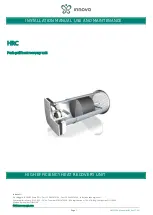
3
EN
The original English version of the manual, from which these translations were taken, has been
independently approved. In case of discrepancy with translated parts, Sprue Safety Products Ltd
confirms that the English guide is true and correct.
This LPG-9B alarm detects LPG (also known as Liquefied
Petroleum Gas, Propane or Butane). This alarm is not
suitable for detecting natural gas (methane).
Positioning
NOTE:
This apparatus should be installed by a competent
person who feels able to install it according to the
instructions.
The information found on the back of the alarm is included
other languages on a label. If relevant, please stick the
label onto the alarm before use.
Write the installation date on your alarm in the area
provided.
The LPG alarm is suitable
for use in domestic
premises and caravan
holiday homes.
WARNING:
This alarm will only indicate the presence of
LPG gas at the sensor. LPG gas may be present in other
parts of the property.
The alarm should be installed in any room where a gas
leak is possible to occur. The most likely sources for a LPG
Gas leak are cookers.
As LPG is heavier than air it will naturally fall and build up
at a low level in the room. The LPG-9B alarm should be
placed below the level of a possible gas leak, at a low level
in the room, ideally within 10cm of the floor.
Do not locate your alarm:
• in an enclosed space (e.g. in a cupboard or behind a
curtain);
• next to a door or window;
• next to an extractor fan;
• in an area where the temperature may drop below
−5°C or exceed 50ºC;
• where dirt and dust may block the sensor;
• in a damp or humid location.
• Its location should not be too close to openings or
ventilation ducts since the airflow at these places
may be high and may locally decrease the gas
concentration.
The alarm should not be installed immediately above or
next to gas appliances since small gas releases may occur
before ignition that may result in unwanted alarms.
Write your Gas Emergency Helpline number on the label
provided and keep this accessible at all times.
Understanding the product’s indicators
The product is designed to immediately alarm when it is
exposed to flammable gas at a level of 10% of the Lower
Explosive Limit (LEL) or higher.
When flammable gas is detected a loud audible signal will
be emitted and the alarm LED will flash red every second.
Fault / End of life signal
The Power LED will flash green every 40 seconds to indicate
that the alarm is receiving power from the batteries and is fully
operational.
The unit continuously checks the settings of its sensor and
circuitry. If any of these settings are found to be incorrect then
the alarm will emit a audible chirp twice every 5 minutes for
up to 30 days. Replace unit immediately.
IMPORTANT:
This does NOT mean that the alarm has
detected LPG Gas.
Low battery
If the batteries are low then the alarm will emit a single
audible chirp every minute for up to 30 days. Replace
batteries immediately.
IMPORTANT:
Replace batteries only with ‘AA’ Lithium
type: Duracell LF1500; Energizer L91; GP 15LF.




































